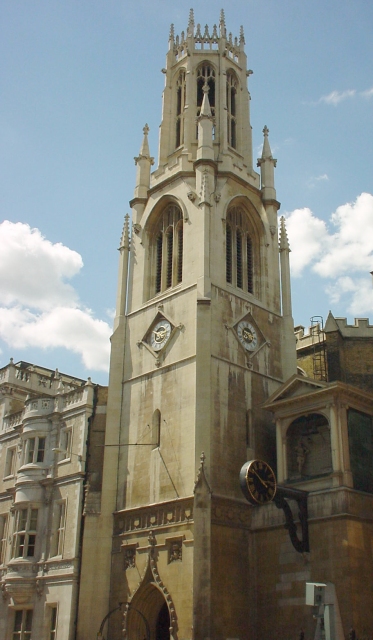- St Dunstan-in-the-West
Infobox church
name = St. Dunstan-in-the-West
fullname =
color =

imagesize =
caption = Photo of St. Dunstan-in-the-West today
landscape =
denomination =Anglican , earlierRoman Catholic
diocese =
parish =
division =
subdivision =
founded_date =
founder =
architect =
style =
constructed_date =
dedicated_date =
closed_date =
demolished_date =
bishop =
priest =
archdeacon =
dean =
provost =
rector =
canon =
prebendary =
curate =
chaplain =
vicar =
deacon =
abbot =
minister =
seniorpastor =
pastor =
address =Fleet Street ,City of London
country =United Kingdom
phone =
website =The church of St Dunstan-in-the-West is in
Fleet Street inLondon . A fragment of the old churchyard remains near "Bream's Buildings" [ "London:the City Churches” Pevsner,N/Bradley,S New Haven, Yale, 1998 ISBN 0300096550] .First founded around 1000 AD, there is a possibility that a church on this site was one of the Lundenwic strand settlement churches, like
St Martin's in the Fields , the firstSt Mary le Strand ,St Clement Danes and St Brides. These may well pre-date any of the churches within the City walled area. It was first mentioned in 1185. Henry III gained possession of it and its endowments fromWestminster Abbey by 1237 and then granted these and the advowson to the 'House of Converts' ie of the converted Jews, which led to its neglect of its parochial responsibilities. This institution was eventually transformed into the court of theMaster of the Rolls .The present building was built on its predecessor's churchyard to allow the widening of
Fleet Street ["The Visitors Guide to the City of London Churches" Tucker,T: London, Friends of the City Churches, 2006 ISBN 0955394503] , and was designed by John Shaw the Elder (1776–1832) who died before the church was completed so it was left in the hands of his son John Shaw the Younger (1803–1870) in 1833 [ Pevsner(Ibid)] . It is based on the design ofSt Helen's Pavement inYork . The Shaws were prominet architects of Fleet Street who designed two other buildings (now offices) close to the church.The church's facade holds an extraordinary chiming clock, with mannequins which strike the bells with their clubs. They perhaps represent
Gog and Magog , the whole clock is mounted in a separate pavilion and dates from 1671 and adorned the previous church, perhaps commissioned to celebrate its escape from destruction in theGreat Fire of London of1666 [Mentioned in Pepys Diary "Samuel Pepys-The Shorter Pepys" Latham,R(Ed) p484: Harmondsworth,1985 ISBN 0140094180] . On the rebuilding by the Shaws it was exiled, in 1828, to a mansion inRegent's Park , which became the St Dunstan's College for the blind. It was returned by the generosity ofLord Rothermere , the press baron, in 1935 to ostensibly mark the Jubilee of King George V.There is also a statue of
Queen Elizabeth I , placed above the entrance to the old parochial school in 1766, which was taken from the front of the old Ludgate which had been demolished at that time. This statue dates from 1586 and hence contemporary with her, it is thought to be the oldest outdoor statue in London. Within the porch below are three statues of ancient Britons also from the gate which were probably meant to representKing Lud and his two sons.Apart from losing its stained glass, the church survived the Blitz largely intact ["The Old Churches of London" Cobb,G: London, Batsford, 1942] .
Adjacent to the Virgin Queen is a bust of
Lord Northcliffe , the newspaper proprietor; he and Rothermere were the Harmsworth brothers. In 1896 they initiated the first popular daily newspaper, the "Daily Mail " and founded the "Daily Mirror" in 1903. Northcliffe acquired "The Times" in 1914. They were the founders of modern mass circulation journalism.Samuel Pepys mentions the church in his diary but he only knew the old medieval building which was taken down in the early 19th century because it caused congestion to part of Fleet Street [ "The City of London Churches" Betjeman,J Andover, Pikin, 1967 ISBN 0853721122] .The church has associations with many famous people, for example:
*Izaak Walton was asidesman here ["The Churches of the City of London" Reynolds,H: London, Bodley Head, 1922] .
* The poetJohn Donne held the benefice here from 1624–31, while he was Dean of St. Paul’s.
*William Tyndale , who pioneered the translation of the Bible into English, was a lecturer.
* Lord Baltimore, who founded the State ofMaryland , was buried here in 1632; as was his son.
* The diaristSamuel Pepys worshipped here a number of times. The church has been associated with theWorshipful Company of Cordwainers (old English for shoemakers) since the fifteenth century. Once a year the company holds a service here to commemorate the benefactors John Fisher and Richard Minge, after which children used to be given a penny for each time they ran around the church.St Dunstan is the only church in England to share its building with the Romanian Orthodox community.
Notes
*
St Dunstan
*List of churches and cathedrals of London
* [http://www.shaw-hardwick.co.uk/ website dedicated to both of the Shaws]
* [http://www.radur.homechoice.co.uk/roc.html Romanian Orthodox Church website]External links
* [http://www.stdunstaninthewest.org/ St Dunstan in the West website]
* [http://london.lovesguide.com/dunstan-in-the-west.htm Church Bells of the City of London - St Dunstan in the West]
* [http://www.ajsw.org.uk/events/ Lunchtime concerts at St Dunstans]
Wikimedia Foundation. 2010.
